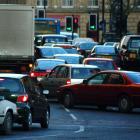For many people, a large part of their direct emissions are created by using their car. One of the most common uses of a person's car is to get to work. You can drive less by using public transportation, carpooling, biking or walking instead of your car. This will make enormous reductions in the amount of emissions you cause everyday.
If these methods of transportation are not an option then try changing your driving habits. Even if you have purchased a small car, when you drive at speeds over 95 km/h you greatly reduce your cars advertised fuel efficiency. Apart from this, sharp accelerations and idling also reduce fuel efficiency. That's why avoiding rush hour is a great way to reduce emissions and drive less.
One last important point to consider is the use of air conditioning (AC) in your car. Using your AC puts more pressure on the motor and waste more gas. On top of this, approximately 71 percent of hydrofluorocarbon(HFC) emissions in 2003 were caused by mobile air conditioners in vehicles.1
Why drive less?
Carpooling doesn’t just save you money on gas and reduce the stress of driving, you can also save on fuel and parking costs. Giving up your car, or driving less contributes to cleaner air and a heavier wallet. Biking and walking are two amazing ways you can get to different locations. Both of these activities are cheaper, more pleasant than sitting in a car for hours everyday. And it will improve your physical and mental health at the same time too.
Whether you want to do it for financial, social, environmental, health or quality of life reasons any of these are great arguments to start driving less today.
1U.S. Environmental Protection Agency, Office of Transportation and Air Quality. Greenhouse Gas Emissions from the U.S. Transportation Sector 1990-2003

